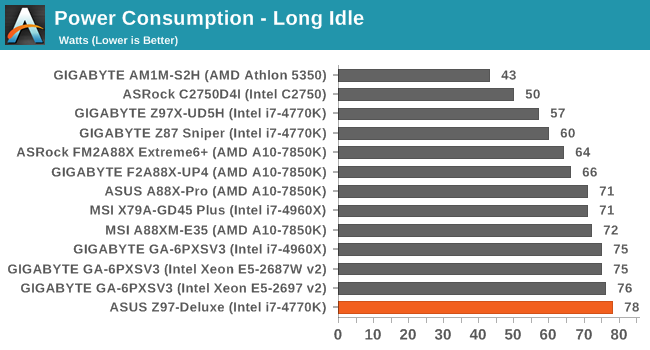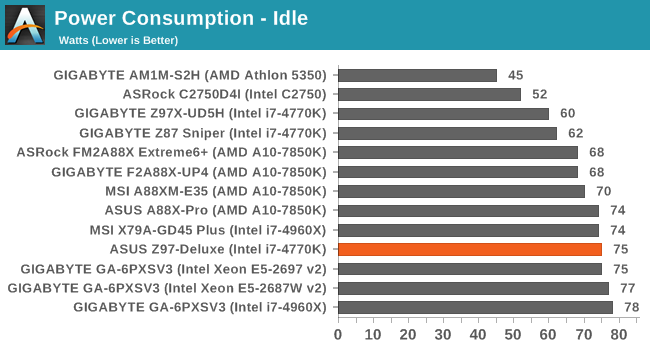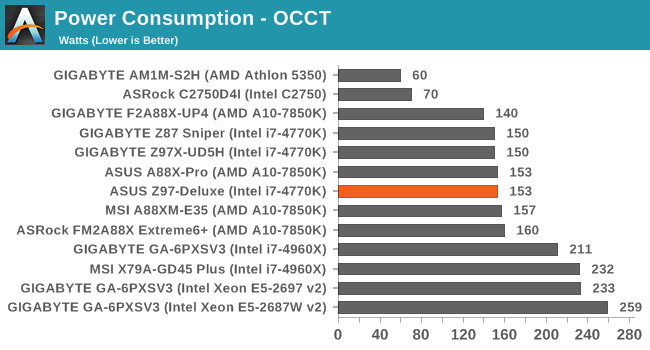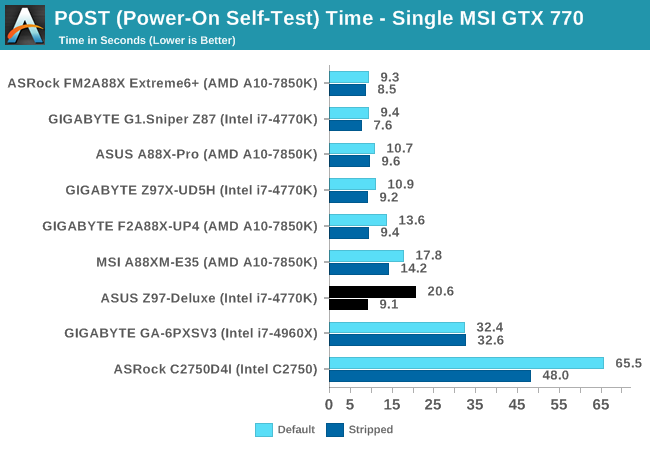ASUS Z97-DELUXE (NFC & WLC) Review: With Two Thunderbolt 2 Too
by Ian Cutress on May 16, 2014 11:00 AM EST- Posted in
- Motherboards
- Intel
- Asus
- NFC
- 802.11ac
- Thunderbolt 2
- Z97
- Wireless Charging
Many thanks to...
We must thank the following companies for kindly providing hardware for our test bed:
- Thank you to OCZ for providing us with PSUs and SSDs.
- Thank you to G.Skill for providing us with memory kits.
- Thank you to Corsair for providing us with an AX1200i PSU, Corsair H80i CLC and DRAM.
- Thank you to ASUS for providing us with the AMD HD7970 GPUs and some IO Testing kit.
- Thank you to MSI for providing us with the NVIDIA GTX 770 Lightning GPUs.
- Thank you to Rosewill for providing us with PSUs and RK-9100 keyboards.
Test Setup
| Test Setup | |
| Processor |
Intel Core i7-4770K ES 4 Cores, 8 Threads, 3.5 GHz (3.9 GHz Turbo) |
| Motherboard | ASUS Z97-Deluxe (NFC + WLC) |
| Cooling |
Corsair H80i Thermalright TRUE Copper |
| Power Supply |
OCZ 1250W Gold ZX Series Corsair AX1200i Platinum PSU |
| Memory | G.Skill RipjawsZ 4x4 GB DDR3-1600 9-11-9 Kit |
| Memory Settings | 1600 9-11-9-27 1T tRFC 240 |
| Video Cards |
MSI GTX 770 Lightning 2GB (1150/1202 Boost) ASUS HD7970 3GB (Reference) |
| Video Drivers |
Catalyst 13.12 NVIDIA Drivers 335.23 |
| Hard Drive | OCZ Vertex 3 256GB |
| Optical Drive | LG GH22NS50 |
| Case | Open Test Bed |
| Operating System | Windows 7 64-bit SP1 |
| USB 2/3 Testing | OCZ Vertex 3 240GB with SATA->USB Adaptor |
Power Consumption
Power consumption was tested on the system as a whole with a wall meter connected to the OCZ 1250W power supply, while in a single MSI GTX 770 Lightning GPU configuration. This power supply is Gold rated, and as I am in the UK on a 230-240 V supply, leads to ~75% efficiency > 50W, and 90%+ efficiency at 250W, which is suitable for both idle and multi-GPU loading. This method of power reading allows us to compare the power management of the UEFI and the board to supply components with power under load, and includes typical PSU losses due to efficiency. These are the real world values that consumers may expect from a typical system (minus the monitor) using this motherboard.
While this method for power measurement may not be ideal, and you feel these numbers are not representative due to the high wattage power supply being used (we use the same PSU to remain consistent over a series of reviews, and the fact that some boards on our test bed get tested with three or four high powered GPUs), the important point to take away is the relationship between the numbers. These boards are all under the same conditions, and thus the differences between them should be easy to spot.



Power consumption while at idle and long idle seems relatively high, especially compared to the UD5H and another one of the boards we have tested but not published yet. The load power consumption however is lower, suggesting that perhaps there are a few features on the Z97-Deluxe that consume power at idle.
Windows 7 POST Time
Different motherboards have different POST sequences before an operating system is initialized. A lot of this is dependent on the board itself, and POST boot time is determined by the controllers on board (and the sequence of how those extras are organized). As part of our testing, we are now going to look at the POST Boot Time - this is the time from pressing the ON button on the computer to when Windows 7 starts loading. (We discount Windows loading as it is highly variable given Windows specific features.) These results are subject to human error, so please allow +/- 1 second in these results.

One of the big features out of the Z97 motherboards we have tested so far is the long POST times when left at default (the UD5H that formed the basis of our first Z97 review was the exception). However when stripped of controllers, the Z97-Deluxe nudges a nine-second POST time.










45 Comments
View All Comments
aron9621 - Saturday, May 17, 2014 - link
The Z87 Deluxe Quad uses a PLX switch (a PEX8608 I believe) for the PCI Express 2.0 lanes coming from the chipset. It's a shame given the price category the Z97 Deluxe doesn't do the same and limits the simultaneous usage of the SATA Express/M2/Thunderbolt ports.UltraWide - Friday, May 16, 2014 - link
Fan curve control from the BIOS, this is worth the GOLD color! WOW I have been waiting for such a feature for the past 10 years.ASUS you got my money and vote. :thumbsup: x 2
OuchIAteMyself - Friday, May 16, 2014 - link
It has been worth it for me to pay more for these premium motherboards. I'm using a P5B Deluxe bought in 2006 to post this comment and it's still going strong. ASUS even released a BIOS update that allowed me to upgrade to a Q9550 processor which is fairly modern. I'll buy ASUS again when I build a new system within the year.pt2501 - Friday, May 16, 2014 - link
LOL I had that the P5B Deluxe for 5 years and thought it was simple, powerful, and rock solid. For the price it offered up the best overclocking and when I built it in late 2006 I paired it with the lowest of the then new core 2 duo (1.6 GHz model). It received a plethora of updates that allowed it to later upgrade to use the top the Cord 2 Duos/Quad cores. I later put in a 3.0 Ghz duo core with the added cache for better performance and maxed out the Ram capacity without any loss of stability. The board never failed I eventually recycled it for lack of anyone wanting a desktop. Now i run an older P8Z68-V Pro/Gen3 with an i5 2500K. The support from Asus for all my boards has been outstanding.I felt like I ponied up alot more cash for this board but the difference in all the features more than pays for itself over time. UEFI, 4 way SLI/Crossfire/TPU/EPU: you can literally do anything with this board and I have never felt like I was missing out on anything.
Most likely unless Asus starts making garbage, if you buy one of their boards my experience has been that you can use it until the subsequent technology becomes completely obsolete.
AssBall - Sunday, May 18, 2014 - link
The DELUXE set from Asus has always been top notch and rock solid. My first build ever was Lots of overclocking and tweaking options. The power delivery is some of the best in the industry, IMO. The new UEFI BIOS's are sweet to work with. Now they also put some decent integrated sound processors on the boards too, which adds a ton of value in my book.Their Pro stuff is really good too if you want a simple overclock system or a 24/7 workstation. The only thing better than an ASUS board is a new ASUS board, heh.
jibz - Friday, May 16, 2014 - link
Nice review. I like the fact that you added audio benchmarks. What I'd like to see included are the numbers for a good add-on card, if only to establish some kind of upper echelon. I understand that it's not fair to compare a 300$ sounds card to the one included on a 300$ motherboard, but it'd help to put the numbers in perspective.cjs150 - Friday, May 16, 2014 - link
Lovely looking board but someone needs their head examined on the storage.This is a top end board it should be capable of having a big GPU, m2 drive as boot drive and ultra fast storage via thunderbolt
xeizo - Friday, May 16, 2014 - link
You could say I use only Asus DeLuxe mobos as I have both the P5Q-DeLuxe and the P8Z68-DeLuxe/G3 currently up and running ;-)The P5Q-DeLuxe has been running since 2008 and 24/7 for the last three years(web/music/movie/nas-server). The P8Z68 is the gaming/development/music production/workstation and performs admirably with dual SSD:s, 16GB RAM and a single GTX770(as I only use 1080P). Very happy with these mobos, 4xUSB3 and 4xSATA6 is very usable on the P8Z68, good for being from 2011 ... It also has no problems remaining stable above 5GHz on water with 8x100% load like forever ....
However, next mobo will be made for Haswell-E with ZX99(?), Z97 is too much of a sidegrade and more cores is good to have when compiling. Higher clocked Xeons are only damned expensive :(
wwwcd - Friday, May 16, 2014 - link
Board FeaturesASUS Z97-Deluxe (NFC + WFC)
...........
Chipset Intel Z87
...........
WoW :D
Ian Cutress - Friday, May 16, 2014 - link
AHA! Re-using old table templates, thanks for the catch :D